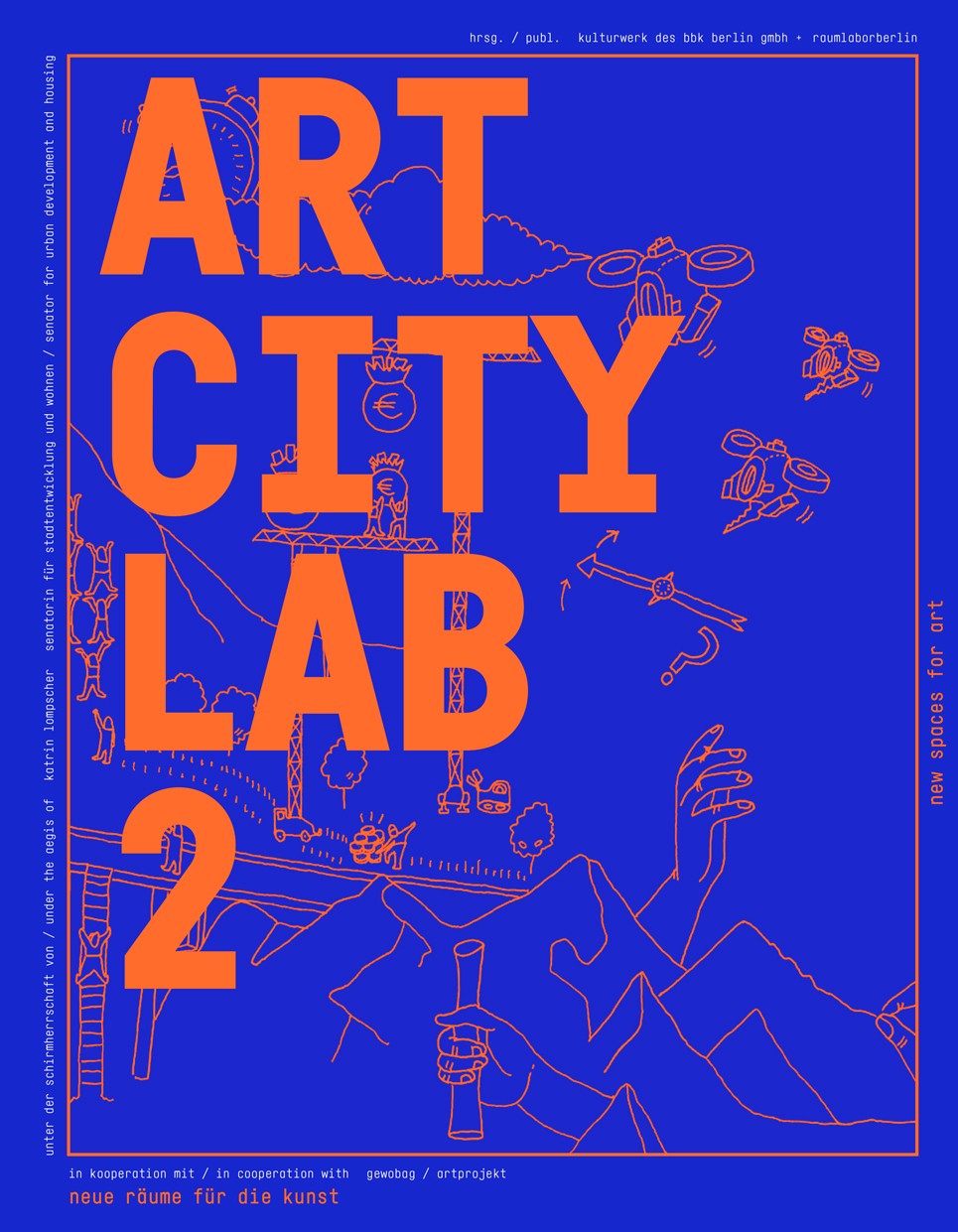ART CITY LAB 2 / new spaces for art

New spaces for art
How can Berlin's artists* be kept in the city? How does a housing association work with an initiative or a private developer? How do you close the gap between financing needs and funding programmes? How can places for art production have a positive effect on the neighbourhood? The studio commissioner for Berlin , Dr. Martin Schwegmann, and raumlaborberlin developed and discussed these questions together with the city-owned housing association Gewobag, the private developer Artprojekt and TTI in a cooperative process with artists, sustainability banks, cooperatives, senate administrations, members of parliament, scientists and planners.
(c) 2019, published by the kulturwerk of the bbk berlin gmbh + raumlaborberlin, ZK/U Press
The publication can be ordered from the following provider: www.bookspeopleplaces.com/
ISBN 978-3-945659-14-4
Price: DE: 20€ / AT: 20,60€ / CHF: 25
Result:
There are innovative approaches to how to cooperate constructively in new alliances and how art production sites can have a long-term stabilizing effect on neighbourhoods. Examples are the Haus der Statistik, the ZK/U or ExRotaprint. An actor landscape of alternative donors and developers is establishing itself, but they need concrete interfaces to the cities administrations, funding schemes and beyond.
Key findings and demands of the publication:
It is necessary to secure, create and integrate new places of artistic work in the city on a permanent basis:
- to network heterogeneous actors and to make them capable of action,
- to bundle implementation knowledge in central offices and to strengthen existing advisory centres,
- to promote voluntary commitments by private real estate companies (3% for affordable art and cultural areas in inner-city new buildings),
- to provide a quota for art and cultural areas also in the cities own properties,
- as well as integrating positive individual examples into a concerted overall strategy (Urban Development Plan, Art Development Plan, etc.).
Background:
In the study Art City Lab from 2014, raumlaborberlin in cooperation with the fine artists association berlin (bbk berlin e.V.) and the Senate Administration for Urban Development and Environment investigated the creation of affordable new spaces for the production of art. Currently, about half of at least 8,000 fine artists are looking for affordable studios in the city. The trend is rising, as around 350 affordable studios are lost every year. This demand is offset by "only" 936 subsidized studios and studio flats. The situation is dramatic, time is pressing! Tendencies such as in London or New York, where artists are largely pushed into peripheral areas, are threatening. For Art City Lab 2 in 2018, innovative concepts and concrete implementation proposals were examined in two workshops at the Hafenplatz in Kreuzberg in order to clarify how affordable space for art production and living can be developed in the city - both in new buildings and in existing buildings. The resulting publication summarises the results and is intended to stimulate further discourse.
Quotations
Katrin Lompscher, Senator for Urban Development and Housing:
"With increasing construction activity, space is also becoming increasingly scarce and competition for land is growing. [...] But Berlin needs creative people, even in the city centre. Because only mixed city quarters are alive".
Markus Terboven, Gewobag:
"For the integration of new, affordable locations for studios and other artistic uses to succeed, we have to find out where in the city there are still interesting, unused spaces. And we have to analyze how we can create resilient organizational and financing structures [...]".
Thomas Hölzel, Art Project:
"Out of personal concern to find art and artists only in the periphery of the city at some point, to lose them completely from the cityscape, we at Artprojekt decided to create a fixed quota of three percent for affordable studios of different sizes and possible uses in our future city projects.
Dr. Martin Schwegmann, studio commissioner for Berlin:
"The question of the production of affordable spaces for working and living, also for art and culture, is the key issue if Berlin wants to preserve its diversity in the future. This requires a diversification of the actor landscape and the formation of new powerful networks. Helping people to help themselves and safeguarding existing locations must be given political priority".
Andrea Hofmann and Christof Mayer, raumlaborberlin:
"In all discussions and negotiations about new cooperations, it is essential not to lose sight of the actual goal: the long-term safeguarding of living locations for art production.
What is ART CITY LAB 2 ?
- A network/platform of users, planners and property developers as well as financing organisations who want to create new, affordable spaces for art.
- A method/toolbox to develop, build and operate new spaces for art
- A framework for knowledge production of texts, maps, visualisations, requirement and promotion catalogues, with publications such as ARTCITYLAB2 (ISBN 978-3-945659-14-4), published in August 2019.
- The occasion and impulse for joint work and the creation of new spaces for art.
- Art CL2 should become concrete in pilot projects!
/////////////////////////////////////////////////////////////////////////////////////////////////////////////////////////////////////////////////////////////////////
Languages: English & German
ISBN: 978-3-945659-14-4
Publishing House/ Publisher: ZK/U Press
Publisher/ Publisher: Kulturwerk des bbk berlin GmbH + raumlaborberlin (Dr. Martin Schwegmann; Andrea Hofmann, Christof Mayer)
Editorial Board: Andrea Hofmann, Christof Mayer, Johannes Noske, Dr. Martin Schwegmann, Dr. Alexandra v. Stosch
Editorial Assistant/ Assistant Editorial Board: Tomma Suki Hinrichsen
Translation: Jonathan Lutes, Patrick Sheehan
Editing/ Copyediting: Janina Lücke, Monika Römer
Design + Concept/ Design + Concept: Lanestudio/ Lars Neckel
Illustrations: Maria Garcia, Tomma Suki Hinrichsen
Diagrams: Tomma Suki Hinrichsen, Sophia Sundqvist
Infographics: Lars Neckel
Set with: Make Mono
Print: Europrint Medien GmbH, Berlin
Picture credits/ Photography Credits: Elisabeth Haentjes, Andrea Hofmann, Anne Kiefer, Julia Rückeis, Martin Schwegmann
Under the Aegis of: Katrin Lompscher, Senator for Urban Development and Housing
Kindly supported by: Gewobag, ARTPROJEKT, tti gruppe, Senate Department for Culture and Europe